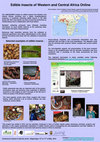Papers by Tchibozo Severin

Via the project LINCAOCNET financed by the Fonds francophone des Inforoutes and the Belgian Coope... more Via the project LINCAOCNET financed by the Fonds francophone des Inforoutes and the Belgian Cooperation, information on edible insects from 10 Western and Central African Countries were collected. The results show that between 7 to 23 species are eaten in the different countries. The preferred taxa also differ largely between countries and regions. The study combined onsite collecting fieldwork with interviews from local population on their traditional knowledge. For example the offer on the different market places, the applied prices and recipes were taken into account. The collected information was put online using following international Biodiversity Information standards (http://gbif.africamuseum.be/lincaocnet/). The outreach to the general public and local users was particularly addressed within the project. In this regard the local common names were both provided in written form, but also recorded for proper pronunciation in the local languages. Public awareness activities in ...
Applied and Environmental Microbiology, 2004
Accumulative indirect evidence of the epidemiology of Mycobacterium ulcerans infections causing c... more Accumulative indirect evidence of the epidemiology of Mycobacterium ulcerans infections causing chronic skin ulcers (i.e., Buruli ulcer disease) suggests that the development of this pathogen and its transmission to humans are related predominantly to aquatic environments. We report that snails could transitorily harbor M. ulcerans without offering favorable conditions for its growth and replication. A novel intermediate link in the transmission chain of M. ulcerans becomes likely with predator aquatic insects in addition to phytophage insects. Water bugs, such as Naucoris cimicoides, a potential vector of M. ulcerans, were shown to be infected specifically by this bacterium after feeding on snails experimentally exposed to M. ulcerans.
In response to population growth, limited natural resources, food security problems in many low-i... more In response to population growth, limited natural resources, food security problems in many low-income regions of the world (particularly in the least developed countries), insects - often considered as nuisances or pests - have emerged in recent years as a possible response to malnutrition, protein shortages and micronutrient deficiencies. Entomophagia - the practice of eating insects - is already widely practiced. For a long time and in many countries of the world, insects have been traditionally eaten by humans for their food.

Uploads
Papers by Tchibozo Severin